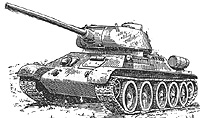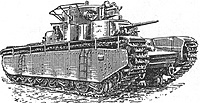 Many computer games seem to come from the “real time strategy” family, and require either lightning reflexes or a handy pause button. This one is a conventional turn-based game featuring operational level combat on the Russian Front in WWII. I don’t know what (if any) relationship this computer game has to a board wargame of the same name that was available in the 1980s. The concept is simple. The German forces have a large salient, with the intention of retaining it as the base for their coming summer offensive. The Russians plan a pincer movement to pinch it out before the spring thaw sets in.
Many computer games seem to come from the “real time strategy” family, and require either lightning reflexes or a handy pause button. This one is a conventional turn-based game featuring operational level combat on the Russian Front in WWII. I don’t know what (if any) relationship this computer game has to a board wargame of the same name that was available in the 1980s. The concept is simple. The German forces have a large salient, with the intention of retaining it as the base for their coming summer offensive. The Russians plan a pincer movement to pinch it out before the spring thaw sets in.
Most units are at battalion / regimental level, with bonuses provided for divisional integrity. There are two turns per day. I reckon that the hexes are about 3 km across. Each turn, units get to move and perform one action (attack, extended move, entrench, etc). If an opposing unit can be overrun, this does not count as an action – so a powerful force can make deep inroads into a flimsy defence during a single turn. It is also possible to make sequential attacks on the same unit – another way of carving into a defensive position.
The computer assistance is well thought out, with support for combat, replacements, supply and so on. This is the sort of assistance that many would have given half of their dice for in the days of conventional monster board wargames.
The “combat advisor” helps with immediate tactics, and will identify the best odds that you can get (at that particular instant in time), and will identify which assets are needed to achieve those odds. This lets a player see quickly and easily which sectors might be promising for an attack, and which could only be tested with risky low odds assaults. If the same unit(s) would be needed for several attacks, then some difficult decisions have to be made. The player has to do their own assessment on how vulnerable their own lines might be to a counterattack.
The tactical combat display re-calculates the odds as each unit is considered for addition to the fray. The combat results table for the particular terrain is automatically selected. Divisional integrity bonuses work themselves out. Supporting artillery (that is within range) can be included. Armour and anti-tank effects are clear. Column shifts for airpower and leadership can be easily applied. This takes all of the hard work out of a complex conventional boardgame combat system, and automatically marks off units as they complete their action for that turn. It leaves only the usual problems – there are never enough units, support arms, aircraft and so on to go round!
 Replacements are automatically logged. Some appear on schedule, others can be earned by capturing objectives. They are split into infantry & armour. Some quick clicks and you can cycle through all of the units that could accept replacements. This gives more decisions to make, as adding replacements to a unit means that it cannot attack. Does one pull a key combat unit out of the line in order to re-build it? Most units will also recover of their own accord to a limited extent. Note that there is no way of recovering completely destroyed units, so perhaps it is a good idea to send battered units to a “quiet” area while they recover.
Replacements are automatically logged. Some appear on schedule, others can be earned by capturing objectives. They are split into infantry & armour. Some quick clicks and you can cycle through all of the units that could accept replacements. This gives more decisions to make, as adding replacements to a unit means that it cannot attack. Does one pull a key combat unit out of the line in order to re-build it? Most units will also recover of their own accord to a limited extent. Note that there is no way of recovering completely destroyed units, so perhaps it is a good idea to send battered units to a “quiet” area while they recover.
Supply is traced from depots to supply trucks to combat units. Help buttons highlight the quality of supply line between the depots and the trucks, and can estimate how far the lines will extend forward from there in your next turn (assuming that the opposition does not throw a spanner into the works). Another click and you can immediately see how much territory your supply system covers in your current turn. Beware the mud degrading your logistics when the thaw comes. Units also have their own intrinsic supply (to last them when pushing on as part of the spearhead, or to sustain them when the supply chain collapses). Undertaking an action (or defending against an attack) costs a supply point, so units outside the supply chain can only take two or three actions before they are in trouble – and units that are totally out of supply really are in deep trouble.
Aside from the elimination of basic paperwork, there is another advantage that this computerised game has over a conventional boardgame. The Russian offensive starts in the middle of winter, with pristine snow covering the battlefield. Short of spilling tea over a map, computer graphics are the best way of watching the thaw set in to slowly turn the ground into mud.
Korsun Pocket has four levels of computer opponent. There is the option for the random assignment of starting unit values on one or both sides. Enemy units can be hidden on the map until friendly forces approach / stumble across them. If you want to make life easier or harder, enhanced supply radii and adjustments to the combat dice can be chosen (for either side). As player turns are sequential, the game would seem to be ideal for play by mail/email, and this is fully supported by the programme. The “replay opponent’s turn” feature lets you see what a live or computer opponent has done in their turn.
Korsun Pocket is published by “Just Play” (www.justplaynow.com) in conjunction with “Matrix Games” and “Strategic Studies Group”. It requires a Pentium II 400 MHz or equivalent system to run.
I have managed to prevail as the Russians in the 16 turn Western flank scenario against idiot level opposition with all of the opposition units visible - although it might have been better to have been in blissful ignorance of the whereabouts of the 905 HV Stug battalion with its contingent of Elefant/Jagdtiger/whatever. I think that this is the smallest scenario, pitting about 70 Russian units against about 60 Germans. The other “small” scenarios cover the other flank of the salient, the attempted relief attempt, and the final destruction of the pocket. The main scenario covers the complete action around the salient from start to finish, with about 300 Russian units being opposed by about 200 German ones. If you get bored with the wide spaces and comparatively low unit densities in Russia, then the Battle of the Bulge is included to give a change of pace.
Back to Table of Contents -- Lone Warrior # 147
Back to Lone Warrior List of Issues
Back to MagWeb Magazine List
© Copyright 2004 by Solo Wargamers Association.
This article appears in MagWeb.com (Magazine Web) on the Internet World Wide Web.
Other articles from military history and related magazines are available at http://www.magweb.com
